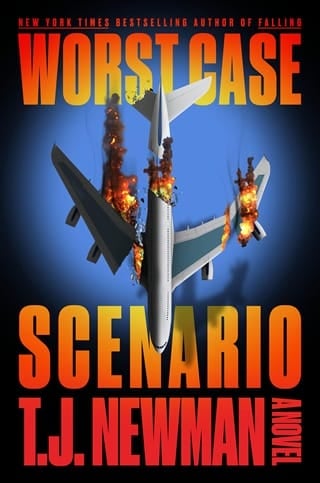Chapter Twenty-Eight
CHAPTER TWENTY-EIGHT
WITH AN AEROSOL hiss from the can, Joss spray-painted a bright red, unmissable, undeniable X across a chunk of concrete before moving on to find the next piece of deadly radioactive debris.
As she waved the Geiger counter over the plane parts and rubble, for the most part, the meter’s needle rested to the left side of its gauge, like a lion hiding in the reeds, waiting to pounce. But occasionally, the needle would perk up and pop over to the right, and the handheld device’s soft, intermittent clicking would grow louder and faster.
That’s when she’d paint an X .
Crews would soon be coming in to clear the debris. The NTSB and the FBI would be intensifying their investigation. They would all need to know which parts of the debris and rubble were clean and which required a more cautious hand, so Joss walked the plant with her Geiger counter doing the due diligence while the firefighters looked on.
They’d been here all day. They were first responders and there’d been no time to figure out what they should and shouldn’t deal with—as if that were even an option. It was their duty to deal with it all. But now, as they watched the sporadic red X s pop up around them, the reality of the work they’d done that day began to sink in.
When you can’t see it or smell it, when the thing that will kill you is invisible, it’s easy to forget about it. They could see and feel the flames, so they dealt with that. But now they wondered what they might have to deal with down the road. What kind of damage had they inflicted on themselves just by being here? Damage that, like a ticking time bomb, might or might not go off.
How many years would it take before they felt safe? Or would they always be waiting, wondering when the bill would come due, when they would be forced to pay the hero’s price?
To Joss’s relief, the X s were less frequent than she had feared. She walked the Clover Hill campus alone, listening to the sound of her own breath in the full-body hazmat suit, realizing how heavy the weight of the fear and anxiety of the day had been now that she could set it down. Letting her head fall forward, she rolled her shoulders back. Unclenching her jaw, she inhaled deeply, held it, then exhaled slowly. It felt like the first time she’d taken a breath since that morning.
Joss looked up at a crumbled portion of one of the cooling towers as she rounded the corner of a building—and stopped in her tracks.
There, in front of her, was the towering, intact tail of the crashed jetliner.
She’d seen it on the security feed earlier, but the video had not done it justice. Now she stood next to it, and it was one of the most jarring images she’d ever seen.
The last few rows of the plane and its gargantuan tail lay on the ground in one piece. The fuselage end had crashed into the wall, making it seem like the building itself had a tail. The Coastal Airways logo was level with the building’s second-story windows, and behind the end of the plane, unearthed grass and dirt formed an enormous skid mark of a divot where the aircraft had dug in its heels in before colliding with the building.
Joss felt tiny as she approached the aircraft cautiously, as if it were a sleeping beast she didn’t want to wake. She told herself to get a grip. The exhaustion was making her ridiculous. Glancing down, she was quickly brought back to reality by the haunting reminders of how the day had started lying there at her feet.
There was an open suitcase. A stuffed pink bear. Someone’s cell phone, the screen shattered. A maroon hoodie painted with a cartoon roadrunner, apparently the mascot of Rhodes Junior High, wherever that was, and Joss thought of the teenager it had belonged to.
The passengers of Flight 235 had been the first casualties in a day that had exacted a heavy toll and Joss realized that their friends and family must have found little relief when the plant’s crisis was avoided.
Their lives had already melted down.
Joss continued her work, sweeping the device over a laptop, then a shoe, then a plastic carrier of soda cans, their tops already popped, as the crash had happened midflight, midservice. There was the charred fabric on a row of seats. There was someone’s sticker-covered water bottle. Each of these things was a tragic reminder of the people who had once claimed them.
But they had no effect on the Geiger counter.
She walked closer, wanding the device over the plane’s tail, reaching up as high as she could on the vertical stabilizer. She rounded the tail cone and walked toward the door—but steered clear of its little porthole window. Joss already had a parade of images that would keep her up at night. She didn’t need to add to it.
As she absentmindedly ran the Geiger counter over the back of the aircraft, unable to stop herself from envisioning what horrors lay beyond that window inside the plane, the needle suddenly shot to the right and the clicking erupted into a frenzy.
Joss stumbled backward and froze, her heart pounding in shock. Spinning, she ran the device over a backpack lying a few steps away. Nothing. She tried a suitcase. Also nothing. Turning back to the plane, she walked slowly toward it, holding the Geiger counter out as she approached.
The device went haywire.
Hands shaking, Joss stepped up to the door’s little window and peered inside.
In the back galley, the body of a flight attendant lay face down, floating. Floating in water that came halfway up the door. Water that had filled the entire plane. Joss held the Geiger counter up to the window, directed it at the water inside, and watched as the needle didn’t even move.
It stayed exactly where it was. All the way to the right, as high as the poison-detecting instrument could measure.
 Fullepub
Fullepub 



